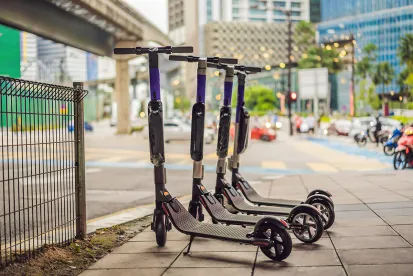Over the last few months, you may have seen more e-scooters on the streets as people have felt safer returning to schools and to the office, and have been gathering more frequently with family and friends. E-scooters have many potential benefits: they help alleviate traffic and city congestion by getting gas-powered vehicles off the streets for short trips; they allow people without personal vehicles to work and to access resources beyond their typical geographical limitations; and, amidst environmental concerns, they have become a transportation alternative that reduces air pollution and noise exposure.
Nonetheless, as more people ride e-scooters, complaints and reports of related injuries have increased, especially by first-time riders. Other issues have also come up. Those who do not ride e-scooters have expressed dissatisfaction with the scattered parking along sidewalks and in public spaces. And while e-scooter use may help reduce pollution when compared with a gas-powered vehicle making the same journey, a North Carolina State University study from 2019 raised concerns about the emissions created during the e-scouter manufacturing process. This concern may be exacerbated by the relatively short life cycle of e-scooters, which means that they must be replaced more often than gas-powered vehicles. Some e-scooter critics have also noted the derivative emissions caused by those vehicles that are required to pick up the e-scooters for daily recharging.
To address these concerns, many states are in the process of adopting laws to allow for the continued use of e-scooters while ensuring public safety.
How California and Other Jurisdictions Are Handling Regulations
Oakland, California, for example, has rolled out e-scooter regulations designed to further protect pedestrian non-riders. The new regulations were implemented in response to a class action settlement in April 2021 alleging that the city’s poor e-scooter parking practices – namely, recurring situations where riders had left vehicles on sidewalks and in other public spaces –violated the Americans with Disabilities Act (ADA). To address the concerns, riders in Oakland are now required to provide photographic proof on rideshare platforms that their e-scooters are properly parked after completing a ride. Additionally, Oakland has required e-scooter operators to reply to any complaints regarding e-scooters within three hours.
In other jurisdictions, e-scooter regulation varies widely at the state and local levels. Some states require riders to be at least 16 years old, while others permit much younger riders (Michigan’s minimum age is 12 years old). Some states impose a driver’s license requirement, while others are either silent or don’t require a license. Speed limits vary as well, with some jurisdictions setting a strict 15 mph limit, while Missouri and other jurisdictions allow operation up to 30 mph. Similarly, some cities and states require helmets, while others have a helmet requirement only for riders under a certain age. At least 10 states have banned e-scooters from use on sidewalks, while others still allow riding on sidewalks and streets. And a few localities have a limit of one rider per scooter.
Some states are also considering legislation that would distinguish e-scooters from bicycles, mopeds, and motorized vehicles. This potential legislation may signal to e-scooter operators that states are beginning to embrace the realities of e-scooter integration into the public’s daily transportation needs. Additionally, in April 2021, New York City announced its partnership with three e-scooter companies for a pilot program in the East Bronx to provide low-cost transportation options to residents in a sustainable and socially distanced way that will ultimately reduce congestion on the roads.
Two Ways E-Scooter Companies Can Prepare For Potential Regulation and Increasing Consumer Awareness
-
Rebrand. Some e-scooter companies have opted to preemptively rebrand their messaging to consumers and to create new logos that champion a desire for inclusivity and sustainability. A number of companies have campaigns aimed at assisting front-line workers and others who have been economically affected by the pandemic.
-
Modify products. Some companies are changing their e-scooter designs to align with city and state goals. Last year, the Consumer Product Safety Commission (CPSC) created a PSA on safe e-scooter riding practices. Taking their cues from this guidance, some companies have created more durable e-scooter models, provided accommodations for disabled riders, and implemented longer-lasting batteries to help reduce vehicle emissions.
As more e-scooters hit the road and continue to transform the mobility landscape, regulation for e-scooter companies remains a moving target. By staying up-to-date on how various localities are contemplating regulating e-scooters, manufacturers may be able to stay ahead of the curve.
Shantazia J. Nash was a summer associate who also contributed to this article.



 />i
/>i

